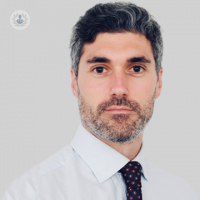Ask an ophthalmic surgeon: What is a cataract?
Written by:A cataract is a common eye condition, particularly amongst older adults, that can cause severe sight loss if not managed appropriately.
Here to provide an expert insight into cataracts, including symptoms and surgical treatment, is Mr Francesco Stringa, award-winning consultant ophthalmic surgeon.

What is a cataract?
A cataract is an area of cloudiness in the natural lens of the eye that causes a decrease in the quality of vision.
Symptoms of cataracts may include:
- seeing faded colours
- having blurry eyesight or double vision
- seeing halos around lights
- having problems seeing in very bright lights
- having problems seeing at night
Cataracts usually develop slowly, and can appear in one or both eyes.
What is cataract surgery?
Cataract surgery is a surgical procedure to treat cataracts, and it is performed by an ophthalmic surgeon.
During surgery, the cloudy lens of the eye is removed and, generally, replaced with a clear artificial lens. The operation is an outpatient (day-case) procedure, meaning that patients can go home on the same day that cataract surgery is performed.
How is cataract surgery performed?
Cataract surgery is done in a clean and sterile environment - the eye theatre - where the patient will be asked to lay down on the operating bed facing up, towards the light of the operating microscope.
The procedure takes approximately 15 minutes, unless the cataract is particularly hard or extra steps are needed (for example, if the pupil is not well dilated).
The eye will be numbed by local anaesthetic, so no pain should be felt during the operation. However, a mild discomfort might be perceived due to the microscope’s light and the water that is needed to keep the eye well lubricated.
The surgeon, after disinfecting the skin around the eye and applying the anaesthesia, will make a very small cut between the white and the coloured part of the eye. The capsule of the lens (called ‘the bag’) will then be opened. Following this, the actual lens will then be removed with an instrument that breaks the lens into very small pieces. Once the old lens is removed, the new artificial lens will then be placed, usually inside of ‘the natural bag’. Finally, the surgeon will provide an antibiotic and seal the cut.
What is the recovery time for cataract surgery?
Following cataract surgery, it is common to experience:
- grittiness
- watery eyes
- blurry eyesight
- sensitivity to light
- red or bloodshot eyes
These side effects usually improve after a few days, but it can take up to four to six weeks to fully recover.
If patients need to wear new glasses after surgery, it is recommended to order them after the eye has completely healed (approximately six weeks after the cataract surgery).
Are there any risks or complications associated with cataract surgery?
Generally, cataract surgery is a very safe procedure. Complications are rare, and can be treated successfully if they do occur.
Complications after cataract surgery may include:
- inflammation
- infections
- bleeding
- swelling
- dislocation of the artificial lens
- retinal detachment
- drooping eyelid
- high pressure inside of the eye
- blurriness of ‘the bag’ of the lens
- decreased vision
The risk of experiencing complications following surgery is higher if the patient has a co-existing condition in the eye or a serious medical condition.
Occasionally, cataract surgery fails to improve vision due to underlying damage in the eye from other conditions (for example, glaucoma or macular degeneration). It is thus important to undergo a thorough eye examination to discover these eye conditions before planning cataract surgery.
If you require surgery for cataracts and wish to consult your options with an expert, do not hesitate to visit Mr Stringa’s Top Doctors profile today.



